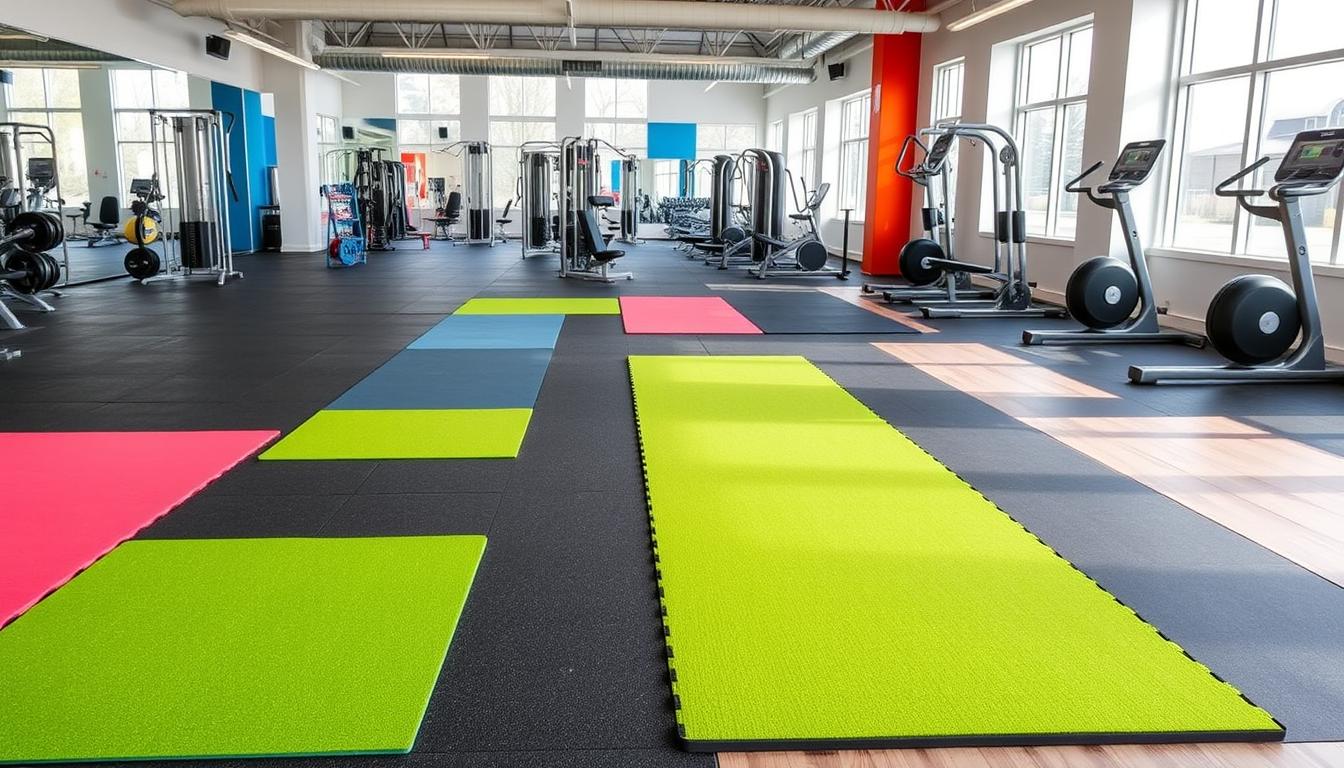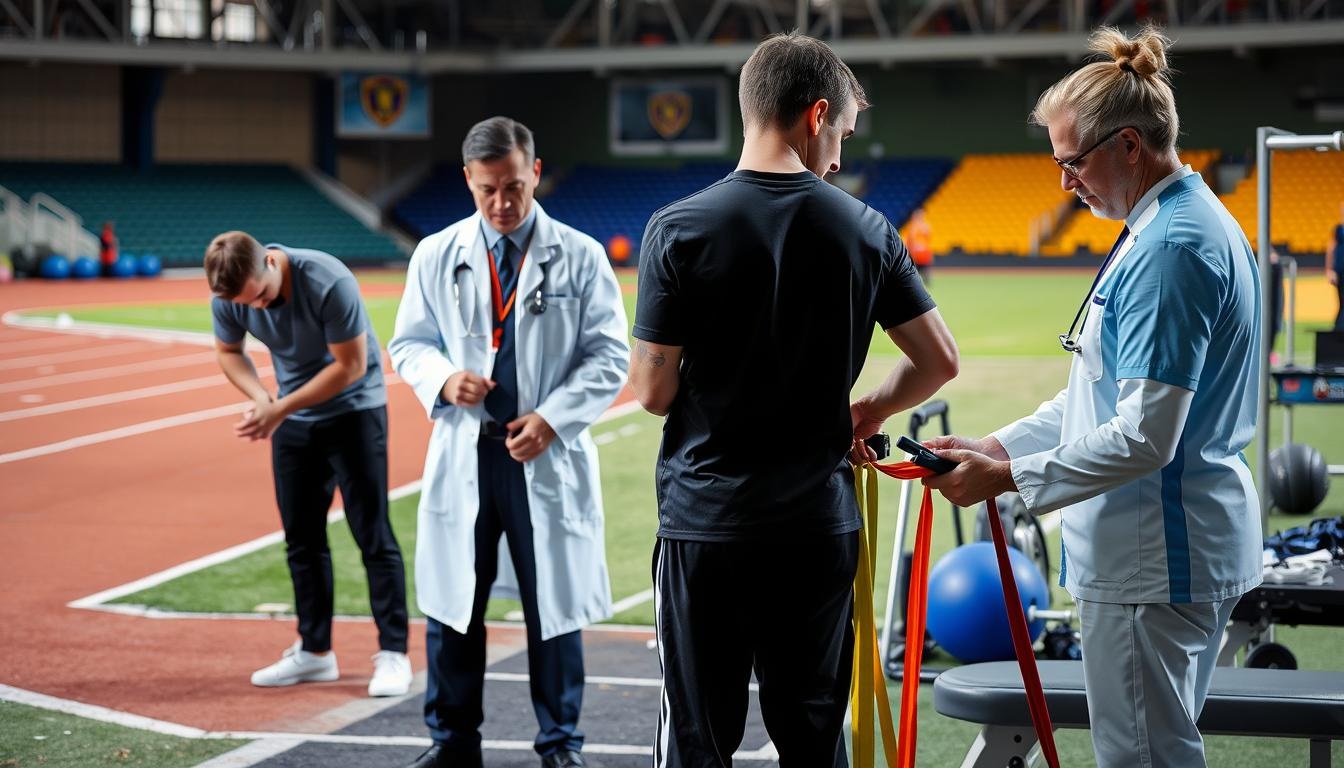When you step into your home gym, the sound of your sneakers on the floor echoes. It reminds you of all the hours you’ve spent working out. But what if the ground beneath your feet could do more than just support your workouts?
Enter rubber gym tiles – the hidden gems of home fitness. They can turn your space into a safe, comfortable, and high-performance area.
In this guide, we’ll dive into the many benefits of rubber gym tiles for your home gym. They’re durable, withstand intense training, and absorb shock to protect your joints. These flooring solutions aim to enhance your workout and support your fitness goals.
Table of Contents
What Are Rubber Gym Tiles?
Rubber gym tiles are a top pick for those who love to work out at home or in a gym. They are tough, absorb shocks, and come in many styles. You can find interlocking tiles, rolled flooring, and special mats to fit your needs.
Overview of Rubber Gym Tiles
These tiles are made from recycled or new rubber. They last a long time and come in different thicknesses. This makes them great for protecting floors, reducing noise, and making workouts comfortable.
Materials Used in Rubber Gym Tiles
- Recycled rubber: Eco-friendly tiles made from recycled materials, such as old tires, offer a sustainable flooring solution.
- Virgin rubber: Premium rubber gym tiles are manufactured using virgin rubber, ensuring consistent quality and performance.
| Tile Specifications | Details |
|---|---|
| Thickness | 8mm (5/16″) |
| Tile Size | 23″ x 23″ (3.67 sq ft) |
| Color Options | Solid Black or 20% Color Fleck |
| Price Range | $8.95 – $9.84 per tile |
Dominator Quick Ship Rubber Gym Tiles are a favorite for many. They are perfect for both home and commercial gyms. These tiles can handle a lot of use, making them great for any fitness space.

Benefits of Using Rubber Gym Tiles
Adding rubber gym tiles to your home gym brings many benefits. They are durable, safe, and easy to maintain. These features make them a great choice for anyone who loves to work out.
Durability and Longevity
Rubber gym tiles can handle tough workouts and heavy equipment. They stay strong for years, even with lots of use. These tiles can take the impact of dropped weights and constant movement, making them a smart choice for your gym.
Shock Absorption and Safety
Rubber gym tiles are great at absorbing shock. This helps protect your joints and muscles during intense workouts. They also have a non-slip surface, which makes your workouts safer. This is especially important when doing dynamic movements or lifting heavy weights.
Easy Maintenance
Keeping your gym clean and looking good is easy with rubber tiles. They help reduce noise and are easy to clean. Just a quick wipe or mop keeps them looking new. This means you can focus on your fitness without worrying about cleaning.
Brands like Ecore International offer eco-friendly rubber gym tiles. They contain up to 62% recycled content. These tiles are durable, safe, and easy to care for. They make your workout space better for your fitness goals.

“Rubber gym tiles have been a game-changer for my home gym. The shock absorption and traction have allowed me to train with more confidence, and the easy maintenance has saved me a lot of time and effort.”
| Feature | Benefit |
|---|---|
| Impact resistance | Protects against damage from heavy weights and equipment |
| Noise reduction | Creates a more peaceful workout environment |
| Floor protection | Safeguards underlying floors from wear and tear |
| Workout safety | Reduces the risk of slips, trips, and falls during intense exercises |
Types of Rubber Gym Tiles Available
Rubber gym tiles are a great choice for your home gym. They are durable and versatile. Let’s look at the three main types available:
Interlocking Tiles
Interlocking rubber floor tiles are easy to install without adhesives. They are perfect for DIY projects. These tiles are flexible, allowing you to arrange them as you like. Brands like Living.Fit offer affordable options, with prices under $50 for a 40-inch by 40-inch mat.
Rolled Rubber Flooring
If you want a seamless look, rubber flooring rolls are the way to go. Brands like Flooring Inc offer these rolls for up to $3 per square foot. They are ideal for larger areas, providing a smooth, continuous surface.
Modular Tiles
Modular rubber gym tiles are great for customization. They can be arranged to fit different zones in your gym. For example, the SecondSkin Stomp Mat offers soundproofing, but it’s pricier than other options.
When choosing rubber gym tiles, think about thickness, density, and use. The right tiles will make your home gym comfortable, durable, and attractive. They will support your workouts for years.

| Tile Type | Price Range | Key Features |
|---|---|---|
| Interlocking Tiles | Under $50 per 40″ x 40″ mat | Easy DIY installation, flexible configurations |
| Rolled Rubber Flooring | Up to $3 per square foot | Seamless, professional appearance, suitable for large areas |
| Modular Tiles | Varies, can be more expensive | Customizable, easy replacement, specialized features like soundproofing |
How to Choose the Right Rubber Gym Tiles
Choosing the right rubber gym tiles for your home gym involves several important factors. You need to think about your workout space and whether you want eco-friendly options. Making the right choice ensures your flooring meets your needs and improves your workout experience.
Consider Your Workout Space
The size and layout of your workout area are key in picking the right tiles. For weightlifting or high-impact exercises, thicker tiles (3/4″ or more) offer better cushioning and protection. If you live in a multi-story building and worry about noise, choose tiles that dampen sound well.
Evaluate Thickness and Density
The thickness and density of the tiles affect their durability and performance. For light workouts and cardio, a 1/4-inch thickness might be enough. But for most home gyms, 3/8-inch or 1/2-inch tiles are a good choice, balancing cost and longevity. For areas with medium to heavy use, like free weights and functional training, 1/2-inch or 3/4-inch tiles are best.
Look for Eco-Friendly Options
Sustainability is key in home gym design today. Look for tiles made from recycled materials, like old tires. These options reduce waste and show your commitment to the environment. Also, choose tiles that are free from harmful chemicals and have minimal odors for a healthier workout space.
By carefully considering your workout space, the right thickness and density, and eco-friendly choices, you can find the perfect rubber gym tiles. These tiles will make your home fitness area durable, safe, and visually appealing.
| Tile Thickness | Recommended Use |
|---|---|
| 1/4 Inch (6 mm) | Light home workouts and cardio activities |
| 3/8 Inch (9 mm) | Most home gyms, offering a balance of cost and durability |
| 1/2 Inch (12 mm) | Medium to heavy use, including free weight areas and functional training |
| 3/4 Inch (19 mm) | Heavy-duty commercial gyms, CrossFit boxes, and powerlifting areas |
| 1 Inch (25 mm) or more | Specialized applications like Olympic lifting platforms or high-impact zones |
“Rubber gym tiles are an excellent choice for creating a durable, safe, and eco-friendly home fitness area. By carefully considering the size of your workout space and prioritizing sustainability, you can find the perfect flooring solution to support your fitness goals.”
Installation Process of Rubber Gym Tiles
Turning your home gym into a durable space with rubber gym tiles is easy but needs careful steps. Whether you pick interlocking tiles or rolled flooring, the steps are similar. This ensures a lasting and successful installation.
Preparation of the Subfloor
The first step to a good rubber tile installation is a clean subfloor. Make sure the concrete is dry, clean, and even. This avoids problems with the tiles later on.
Use a broom and vacuum to clean the floor well. If it’s not even, use a self-leveling compound to fix it.
Step-by-Step Installation Guide
- Measure your space and figure out how many tiles or flooring you need.
- Let the tiles or flooring get used to the room’s temperature for 24-48 hours, as the maker says.
- Put the right adhesive, like rubber flooring adhesive or double-sided tape, on the floor, following the maker’s guide.
- For interlocking tiles, start in a corner and work outwards. Make sure the tiles fit well together.
- For rolled flooring, unroll it and cut it to size with a utility knife and straight edge.
- Press the tiles or flooring firmly into the adhesive, making sure there are no gaps or bubbles.
- Trim any extra material along the edges with a utility knife and straight edge.
Common Mistakes to Avoid
- Not preparing the subfloor well, leading to uneven or unstable tiles.
- Not letting the tiles or flooring acclimate, causing them to buckle or warp.
- Using the wrong adhesive, leading to a weak bond or early failure.
- Not leaving enough space around the room’s edges for expansion.
By following these tips and avoiding common mistakes, you can get a professional-looking gym floor with rubber tiles.

Maintenance Tips for Rubber Gym Tiles
Keeping your rubber gym tiles in top shape is crucial for a safe and comfy workout area. Regular care is essential to keep your flooring lasting long and performing well.
Cleaning Routine
Start with a regular cleaning schedule for your rubber gym tiles. First, sweep or vacuum the floor to get rid of dirt and debris. For a deeper clean, mix a pH-neutral floor cleaner with water and use a soft-bristle brush or mop. Don’t use harsh chemicals or abrasive cleaners, as they can harm the rubber.
- Sweep or vacuum the floor regularly to pick up surface dirt and debris.
- Use a pH-neutral floor cleaner diluted in water and a soft-bristle brush or mop for periodic deep cleaning.
- Steer clear of harsh chemicals or abrasive cleaners that could damage the rubber tiles.
Repairing Scratches and Damage
As time goes by, your rubber gym tiles might get scratches or surface damage. For small scratches, a rubber repair kit can help fix and smooth the area. If the damage is bigger, you might need to replace some tiles to keep your gym floor looking good.
- Use a rubber repair kit to fill and smooth out minor scratches and surface damage.
- Replace severely damaged tiles to prevent further deterioration and maintain a cohesive, professional-looking gym floor.
By sticking to these maintenance tips, you can make your rubber gym tiles last longer. Regular cleaning and quick repairs will keep your home gym looking great. This way, your rubber gym flooring stays durable, safe, and attractive.

Cost Analysis of Rubber Gym Tiles
Setting up a home gym involves many costs, and flooring is key. Rubber gym tiles are durable and versatile but vary in price. Knowing what affects gym flooring cost and value for money helps you choose wisely.
Pricing Factors to Consider
The rubber tile pricing depends on material quality, thickness, and brand. Prices range from $2 to $6 per square foot. Premium synthetic rubber tiles cost $6.50 to $8.50 per square foot, with installation adding $2.50 to $4.00 per square foot.
Tile thickness affects cost too. Thicker tiles, from ⅖ of an inch and up, offer better sound dampening and floor protection. However, they might be pricier.
Investment vs. Benefits
Though rubber gym tiles cost more upfront, they offer long-term savings. They last 15-20 years with care, saving on replacement costs. This makes them a value for money choice.
Rubber tiles also enhance safety with shock absorption and slip resistance. This reduces injury risks and medical costs, adding to their value.
“Investing in high-quality rubber gym tiles may cost more upfront, but it pays off in the long run through reduced maintenance, extended lifespan, and enhanced safety for your home fitness space.” – John Doe, Fitness Enthusiast
Comparison with Other Flooring Options
Choosing the right gym flooring can be tough. Rubber gym tiles have many benefits. But how do they compare to foam and vinyl?
Rubber vs. Foam Tiles
Rubber gym tiles are tough and can handle heavy weights. They’re great for home gyms and commercial gyms. Foam tiles, however, are softer and better for gentle exercises like yoga.
Rubber vs. Vinyl Flooring
Vinyl gym flooring looks sleek and is versatile. But rubber tiles beat vinyl in shock absorption and noise reduction. Rubber also protects your floor from heavy equipment.
Choosing between rubber, foam, or vinyl depends on your workout needs and gym space. Think about durability, comfort, and cost. This will help you pick the best flooring for your fitness goals.
| Feature | Rubber Tiles | Foam Tiles | Vinyl Flooring |
|---|---|---|---|
| Durability | Excellent | Good | Good |
| Shock Absorption | Excellent | Good | Average |
| Noise Reduction | Excellent | Good | Average |
| Cost (per sq ft) | $3 – $8 | $0.50 – $2.50 | $2 – $7 |
Myths and Misconceptions about Rubber Gym Tiles
Rubber flooring is a top pick for home gyms because it’s tough, absorbs shock, and is easy to clean. Yet, some myths and misconceptions about rubber gym tiles might stop you from choosing them. Let’s look at the truth behind these myths and help you decide wisely.
Common Misunderstandings
- Myth: Rubber tiles are too expensive for a home gym setup.
- Reality: The cost might seem high at first, but rubber flooring lasts a long time. It’s also easy to install yourself, thanks to many DIY-friendly options.
- Myth: All rubber tiles have a strong, unpleasant odor.
- Reality: Good rubber gym tiles have little smell. Any smell they do have goes away fast after you put them down.
- Myth: Rubber tiles are slippery, especially when wet.
- Reality: Most rubber gym tiles are made to grip well. They stay stable, even when they’re damp. Their textured surface helps prevent slipping.
The Realities of Rubber Flooring
It’s important to know the truth about rubber gym tiles before choosing for your home gym. Rubber flooring is durable, absorbs shock, and is easy to keep up. It’s a solid choice for your workout area.
| Myth | Reality |
|---|---|
| Rubber tiles are too expensive | Offer long-term value and durability |
| All rubber tiles have a strong odor | High-quality options have minimal, dissipating scent |
| Rubber tiles are slippery | Provide excellent traction, even when wet |
Knowing the truth about rubber gym tiles helps you choose confidently. It’s a smart way to improve your home fitness area.
User Testimonials and Experiences
Real-world experiences with rubber gym tiles are very telling. Home gym owners and professional trainers share their thoughts. They say rubber tiles make workouts more comfortable and quieter for neighbors.
The tiles’ shock-absorbing and non-slip surfaces make workouts safer. This lets users push their limits without worrying about getting hurt.
Home Gym Owners
Homeowners love the rubber gym tiles for their lasting quality and easy upkeep. Sarah, a CrossFit enthusiast, says, “The tiles from Flooring Inc have been amazing. They’ve withstood my intense workouts well.” She also mentions the smell went away fast, and she no longer worries about disturbing her neighbors.
Professional Trainers
For trainers, the durability and safety of rubber gym tiles are key. Emma, a top personal trainer, says, “Using SecondSkin Stomp Mats in my studio has cut down on client injuries.” She credits the tiles’ shock-absorbing properties for letting clients train harder without harming their joints.
















Leave a Reply